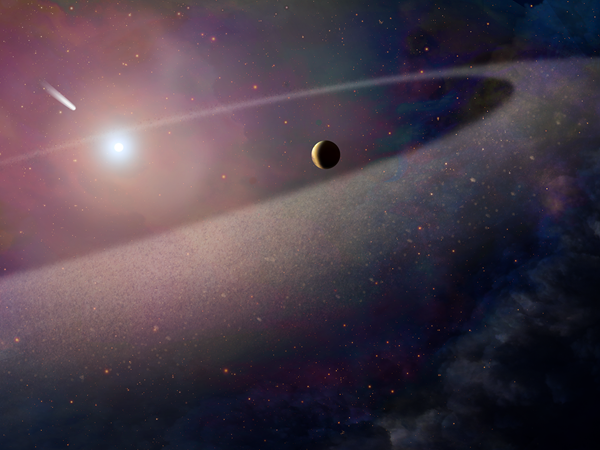Infalling debris is pretty normal in white dwarf systems. Between 25 and 50 percent of white dwarfs show evidence of “pollution” from rocky bodies such as asteroids and even planets as they’re swallowed up by what remains of their sun. A recently-announced observation, however, marks the first time such infalling debris has included comet-like materials, such as ices. The discovery was made by a team of astronomers led by Siyi Xu of the European Southern Observatory in Garching, Germany. The white dwarf in question, WD 1425+540, lies 170 light-years away, in a binary system located in the constellation Boötes. Its companion is a K dwarf star in a wide binary orbit; the two stars are separated by about 2,000 times the distance between Earth and the Sun.
The object that astronomers spied falling into the white dwarf has a chemical makeup similar to that of Halley’s Comet, but a mass about 100,000 times as large and a much higher water content than our solar system’s counterpart. It also contained nitrogen, carbon, oxygen, and sulfur. In fact, “This particular object is quite rich in nitrogen, more so than any object observed in our solar system,” Xu said in a press release announcing the finding.
The discovery was made using observations from the Hubble Space Telescope and the W.M. Keck Observatory, which provided complementary observations that allowed for the determination of elements in the white dwarf’s atmosphere. This observation is so exciting because it provides evidence that this white dwarf not only has an outer belt of objects, like our solar system’s Kuiper Belt, but that the belt has survived the star’s evolution from the main sequence to tiny, cooling remnant. That icy bodies are falling into the white dwarf also hints toward potentially surviving outer planets that have perturbed these faraway objects inward. Alternatively, the white dwarf’s companion could also perturb objects in its Kuiper Belt-lookalike, sending them inward.
Regardless of the reason for the object’s infall, its high nitrogen content is newsworthy, too. Xu explained, “Nitrogen is a very important element for life as we know it.” So perhaps this white dwarf’s solar system once contained planets rich in the elements necessary for Earth-like life.
Once our Sun has exhausted its nuclear fuel, it will eventually end its life as a white dwarf as well. White dwarfs are the remnants of Sun-like stars, about the size of the Earth but hundreds of thousands of times as dense. Because stars like the Sun are those that leave white dwarfs behind, studying them and what remains of their solar systems can shed further light on the number of solar systems that look like ours, as well as the future our own solar system may one day face.










